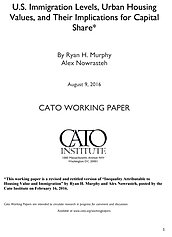We seek to bridge this gap by using the findings from Saiz (2007) that show a one percentage point increase in foreign born individuals as a percentage of the total population corresponds to a one percentage point increase in housing rents. Following the result that the observed increase in inequality is caused by increases in housing prices, we use this to indirectly determine what proportion of the total change in wealth inequality observed by Piketty-Rognlie is attributable to immigrants bidding up housing prices. To make our estimation in the spirit of Saiz’s results, we estimate this for a small cross section of urban counties in America. Doing so restricts the richness of the data available, but extrapolating beyond these types of counties is not externally valid. Our results are consistent with Card (2009), who attributes little of the increase in inequality to immigration.
We started with the county-level data associated with the fifteen largest Metropolitan Statistical Areas in the United States. Because this data was unavailable for the state of Texas in 1970, we then dropped Houston and Dallas. This left us with New York City, Los Angeles, Miami, San Francisco, Philadelphia, Washington, DC, Atlanta, Boston, Phoenix, Riverside, Detroit, and Seattle. Excepting New York City and San Francisco, a single county sufficed to represent the city. We used population-weighted averages of the counties for each of the boroughs to represent New York City and the populationweighted average of San Francisco and San Mateo counties for San Francisco. We calculate the percentage of foreign born in the county population in 1970 and the percentage of foreign born in the county population in 2010 according to the U.S. Census. Our primary variable of interest is the forty year long-difference of foreign born from 1970 to 2010.

